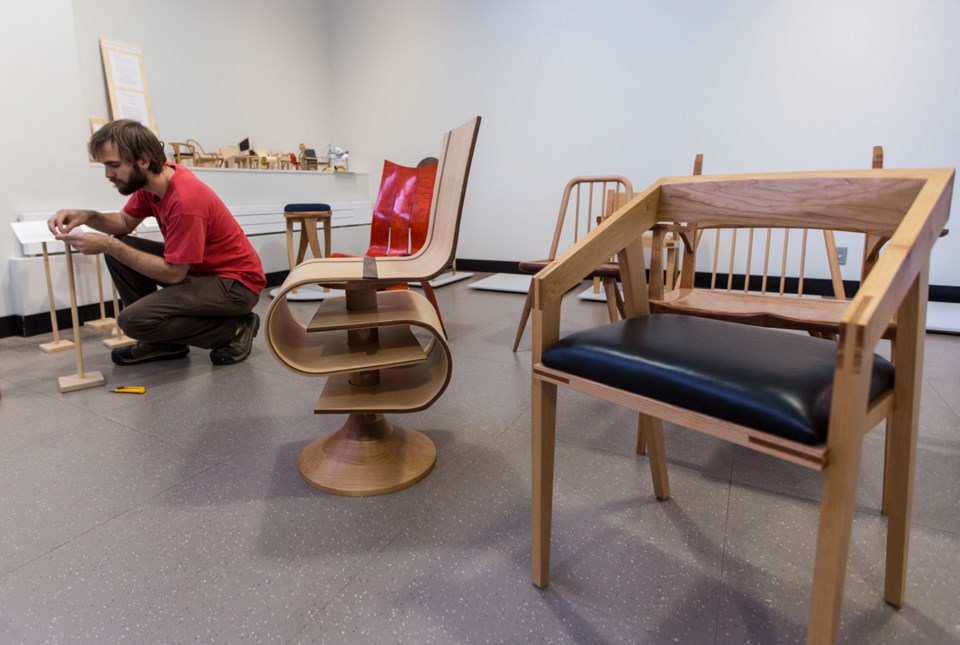For some, the chair is a functional item. For others, a chair adds designer flair to a room.
But for a small group of Camosun College students, the chair is a gateway to the next stage of career development.
That portal will be on display starting tonight at Cedar Hill Recreation Centre, where Camosun’s latest fine- furniture and joinery graduates show off their end-of-year projects in an exhibition called A Chair to Remember.
The final project required each class member to design and build a chair using locally sourced western maple. They each were given 25 board feet (25 one-foot by one-foot by one-inch pieces) and the task of making a chair that could either fit into a small shipping box or could be taken apart to fit into the box and easily put back together when opened.
“The chair is always our final project because seating is one of the most complex parts of joinery,” said fine-furniture and joinery program leader Ken Guenter, who has been teaching the course for 17 years.
Guenter said the chair, apart form being a complex build that will tax his students’ new skills, is a cool challenge as it represents so many things.
“They have function, but they also represent other things — from thrones to electric chairs and everything in between — and they all have meaning,” Guenter said. “The other thing is any other piece of furniture, if it’s not built well, when you lean on it and it falls apart, you can always jump back. But with a chair, we put our faith in those things.
“People expect they will hold and the joinery has to be such that they will hold.”
For those students whose chair, which must be an original design, holds up to human use and to the scrutiny of an expert panel of judges, the chair is also a chance to take their skills to the next level.
The intense 10-month Camosun course, which takes students through the history of furniture, design and function, is considered the first year of a joinery apprentice.
Student Olaf Lokken hopes to carry on in the field and will be looking for work to get the required hours under his belt to become a journeyman.
The fine-arts graduate from the University of Saskatchewan decided to walk from the concert stage and instead work with his hands.
“I’m someone who likes to build things, and I decided I wanted to try this as a career,” he said.
“It seemed like a good fit.”
Lokken designed an intricate rocking chair that features 38 spindles, 16 of them of different lengths.
He said the program and this exhibit have instilled in him the confidence to keep going in the trade.
“It was challenging, and I think I pushed myself a little further than I should have at times, but it turned out well,” he said of the steam bending and curving wood that was required to complete the chair.
Guenter said the program, which has been taught at Camosun for 30 years, gets a lot of students like Lokken who simply want to change course or want to add actual building skills to the creative instruction they’ve had in art classes.
They also get some people fresh out of high school and others in mid-career who see new opportunities developing in cabinet making, shipbuilding and furniture design.
And there seems to be a future in it. Guenter said the small-maker and artisan movement is growing, fuelled by many people looking for unique and one-off designs.
“So we encourage our graduates to come up with a hook so they can sell themselves, sell the story of that piece of furniture,” he said. “That differentiates you from the big companies and will make people want to find you to buy your work.”
He said exhibitions like this one are great for reminding people there are still highly skilled artisans at work.
“It makes them aware there are people doing this on Vancouver Island, that there are people who are actually teaching, learning and producing here.”
The exhibit, which kicks off with a judging event tonight, runs through June 27 at Cedar Hill Recreation Centre’s arts centre.
Judging starts at 1 p.m. today with a best-in-show award announced that evening when the exhibit opens to the public at 7 p.m.
The winner will get $500 donated by the Vancouver Island Woodworkers’ Guild.



